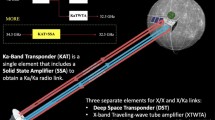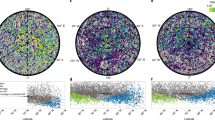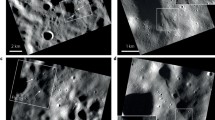Abstract
A basin with an interior about 1000 km across and an outer rim about 2000 km in diameter has been found on the side of Mercury that remained unknown after theMariner 10imaging in 1973–1975. In its size, which is as much as 1/2 of the Mercury's diameter, this formation is one of the largest basins on the terrestrial planets. The presence of other large features of global dimension on this side of the planet suggests their possible asymmetric allocation on Mercury, similar to that on the Moon. New methods of ground-based astronomical observations including data processing with a special software package have been used.
Similar content being viewed by others
REFERENCES
Baumgardner, J., Mendillo, M., and Wilson, J.K., Digital High-Definition Imaging System for Spectral Studies of Extended Planetary Atmospheres. 1. Initial Results in White Light Showing Features on the Hemisphere of Mercury Unimaged by Mariner-10,Astron. J., 2000, vol. 119, pp. 2458-2464.
Dantowitz, R.F., Teare, S.W., and Kozubal, M.J., Ground-Based High-Resolution Imaging of Mercury,Astron. J., 2000, vol. 119, pp. 2455-2457.
Grard, R. and Balogh, A., Returns to Mercury: Science and Mission Objectives,Planet. Space Sci., 2001, vol. 49, pp. 1395-1407.
Harmon, J.K., Perillat, P.J., and Slade, M.A., High Resolution Radar Imaging of Mercury's North Pole,Icarus, 2001, vol. 149, pp. 1-15.
Head III J.W. Surfaces of the Terrestrial Planets,The New Solar System, London: Sky Publish. Corp, 1981, pp. 45-56.
Ksanfomaliti, L.V., High-Resolution Imaging of Mercury Using Earth-based Facilities,Astron. Vestn., 2002, vol. 36,no. 4, pp. 291-301 [Sol. Syst. Res.(Engl. Transl.), 2002, vol. 36, no. 4, p. 267].
Ksanfomaliti, L.V., The Image of Mercury in the Longitudinal Range 210–285b W Obtained Using the Short Exposures Method,Astron. Vestn., 2003, vol. 37,no. 6, pp. 514-525 [Sol. Syst. Res.(Engl. Transl.), 2003, vol. 37, no. 6, p. 469].
Mendillo, M., Warell, J., Limaye, S.S.,et al., Imaging the Surface of Mercury Using Ground-Based Telescopes,Planet. Space Sci., 2001, vol. 49, pp. 1501-1505.
Neukum, G., Oberst, J., Hoffmann, H.,et al., Geologic Evolution and Cratering History of Mercury,Planet. Space Sci., 2001, vol. 49, pp. 1507-1521.
Schultz, P.H. and Gault, D.E., Seismic Effects From Major Basin Formations on the Moon and Mercury,Moon, 1975, vol. 12, pp. 159-177.
Shevchenko, V.V.,Sovremennaya selenografiya(Contemporary Selenography), Moscow: Nauka, 1980.
Shevchenko, V.V., The Structure of the Surface of Mercury's Regolith from Remote Sensing Data,Astron. Vestn., 2002, vol. 36,no. 5, pp. 387-394 [Sol. Syst. Res.(Engl. Transl.), 2002, vol. 36, no. 5, p. 359].
Sprague, A.L., Hunten, D.M., and Lodders, K., Sulfur at Mercury, Elemental at the Poles and Sulfides in the Regolith,Icarus, 1995, vol. 118, pp. 211-215.
Strom, R.G. and Neukum, G., The Cratering Record on Mercury and the Origin of Impacting Objects,Mercury, Vilas., F., Chapman, C.R., and Matthews, M.S., Eds., Tucson: Univ. of Arizona Press, 1988, pp. 336-373.
Trask, N.J. and Guest, J.T., Preliminary Geologic Terrain Map of Mercury,J. Geophys. Res., 1975, vol. 80, pp. 2461-2477.
Author information
Authors and Affiliations
Rights and permissions
About this article
Cite this article
Ksanfomality, L.V. A Huge Basin in the Unknown Portion of Mercury in the 250°–290° W Longitude Range. Solar System Research 38, 21–27 (2004). https://doi.org/10.1023/B:SOLS.0000015152.00598.ed
Issue Date:
DOI: https://doi.org/10.1023/B:SOLS.0000015152.00598.ed




